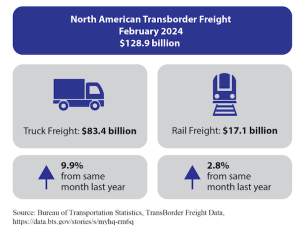The Federal Railroad Administration announced that it had approved Burlington Northern Santa Fe's Electronic Train Management System (ETMS) for use on some of its network. The system uses a digital communications network and a global positioning system to monitor a train's speed, location and other factors. The system will warn a train's crew of any problems and automatically engage the braking system if the crew fails to respond.
The ETMS will overlay with Burlington Northern Santa Fe's existing systems, augmenting what the railroad already has in place.
"We think we have a technology that's reliable, does what it's supposed to do and is affordable," said Burlington Northern Santa Fe spokesman Richard Russack, who declined to comment on the price of developing and rolling out the system.
The railroad was given a waiver by the Federal Railroad Administration in 2003 to proceed with a pilot project to operate ETMS-equipped test trains on a 135-mile corridor between Beardstown, IL, and Centralia, IL. It was then given permission in May to test ETMS on a 300-mile route between Arkansas City, Kan., and Fort Worth, Texas.
Monday's approval means the railroad, whose tracks are mainly in the western two-thirds of the US, can roll out ETMS on 35 freight lines in 17 states. That work will begin in the second quarter.
Burlington Northern Santa Fe will likely have a better idea of what the next phase of the rollout will be once the Arkansas City-to-Fort Worth route is completed, Russack said. The rollout will take several years and will occur on the railroad's densest routes first, he said.
Other railroads, including Union Pacific Corp. (UNP), CSX Corp. (CSX) and Norfolk Southern Corp. (NSC), are also developing technology that the Federal Railroad Administration calls positive train control systems.
The administration has been working for several years to develop positive train control performance standards, Federal Railroad Administration spokesman Warren Flatau said. The standards were published more than a year ago, and the railroads have to show the administration that their software and hardware technologies will meet certain requirements in order to get approval, he said.
Union Pacific, the largest railroad by revenue and which also has tracks in the western two-thirds of the country, will begin a pilot test on its technology this summer on a route between North Platte, NE, and South Morrill, NE, spokesman James Barnes said. It will then test the technology later in the year on a route between Spokane, WA, and Eastport, ID.
"We're looking forward to submitting our own application now that there is a template to follow," Barnes said.
CSX has been working on its system since 1998 and, while it isn't currently conducting field tests, it has done so in the past on a corridor between Augusta, GA, and Spartanburg, SC, spokesman Gary Sease said. CSX has applied with the Federal Railroad Administration seeking permission to conduct additional tests this year, he said.
Sease declined to comment on the cost of the system, saying it is an on-going project.
Norfolk Southern, with tracks mainly in the eastern one-third of the US, is developing what it calls Optimized Train Control. The first phase is in use on a 114-mile route between Charleston, SC, and Columbia, SC, spokeswoman Susan Terpay said. This phase monitors a train's position and the position of switches.
The second phase of the system, which is under design, is a fail-safe system, meaning a train automatically stops if there is any failure of the system, Terpay said. This phase will require Federal Railroad Administration approval, she said.
Norfolk Southern doesn't have a "definitive" cost for the system, Terpay said. (Dow Jones & Company, Inc.)








